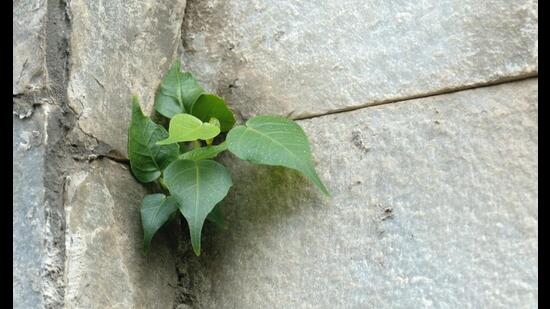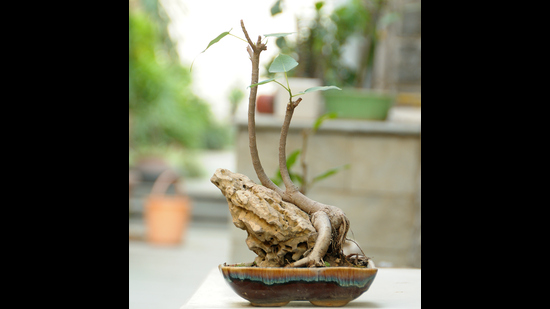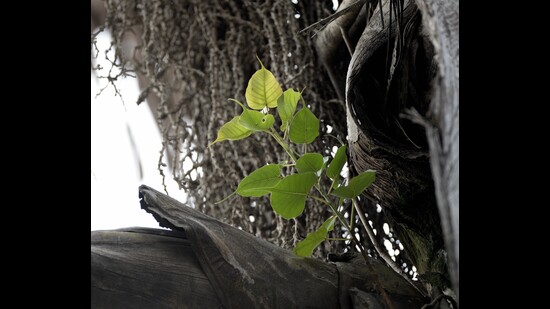Essay: Respect my boundaries, dear peepal
The peepal provides refuge for humans and animals in the scorching summer and is considered a sacred tree in India. A meditation on this magnificent shade tree that can be both useful and destructive
It all began when my gardener refused to pull out a peepal (ficus religiosa, or sacred fig) sapling growing out of a crevice in my boundary wall. Why on earth did the peepal decide to grow between hard stones in the first place? It didn’t seem logical. There was a very fertile flower bed right underneath the wall. It could have been a friendlier option, but then, who am I to decide? If the peepal doesn’t care about its own comfort, is it really my place to intervene? Their life, their choice.

The wall of my house was definitely my concern, though. I respected the gardener’s refusal with a smile. Nothing personal about it. I would never ask anyone to go against their beliefs, not just because I don’t want to hurt anyone’s sentiments – but because I also don’t want to take a risk. There are so many secrets of the universe that have not yet been unravelled. Who is to say whether I’d stand to be harmed if those beliefs turn out to be right?

I have watched the Shahrukh Khan-Rani Mukherjee starrer Paheli. In that film, supernatural activities occurred around an enchanted peepal tree – there were talking puppets and lovesick spirits living in it. They created endless drama, complications, romance, and stress in the lives of the protagonists. The truth is that we live in an oversensitive society, so it is always safe to stay clear of avoidable controversies. As is commonly said in Delhi, panga kyun lena? (Why mess with things unnecessarily?)
Of the two reasons given above, believe whichever you like. The outcome was that the peepal tree was allowed to continue its residence in the wall.
I was reminded of these beautiful words from Delhi’s favourite poet -
“Ug raha hai dar-o-deewar se sabza Ghalib, hum bayaban mein hain aur ghar mein bahar aayi hai.” (Greenery is growing out of the doors and walls, I am in an abandoned state while in my house it is springtime). It was an intimidating thought, I didn’t want that situation in my house.
And thus began the story of my peepal bonsais.

I respectfully suggested to my gardener, “How would you feel if we removed the tree from the wall and planted it in a pot?” He thought about it for a moment and then hesitatingly said yes. I gave him the go-ahead to do the needful. I would have gladly done the deed myself, but the sapling was at a height that my modest stature couldn’t reach. I could have climbed up a ladder, but if I’d had an accident, the gardener would probably have considered it a punishment from the Powers That Be for disturbing a peepal tree.

He carefully transplanted the tree into a terracotta pot. After doing that without any repercussions, he appeared to feel safe. That was a good thing, because this wasn’t the last peepal sapling to sprout out of my boundary wall. He had no hesitation in transplanting saplings in the weeks and months to come. I didn’t anticipate the beautiful outcome of his actions. Now, I look around my garden and see many peepal bonsais everywhere: ones with exposed roots, ones with roots over rock, others in a clump... All of them bring me endless joy.
Peepal trees are truly a gift to the world.

As a child, I enjoyed painting on the peepal’s heart-shaped leaves. I would soak the leaves in water for several days. When the pulp softened, I’d gently scrape at them for many more days, using an old toothbrush. There were times of heartbreak when, despite treating the leaf very gently over a prolonged period, a gaping hole appeared in its middle. But most times, I found myself lucky, and the sturdy arrangement of veins was all that was left of the leaves. With all the green gone, I painted on the leaf skeleton and made beautiful vibrant greeting cards for family and friends.
The peepal tree is worshipped widely across India. It is called the Ashwatha or Bodhi tree, because Gautam Buddha is said to have attained enlightenment under a tree of the same species. Like my gardener, many people avoid uprooting a peepal because of their faith. A good way to save trees really is to add a religious angle for their protection! Preserving the environment is our duty – religious, social, parental, national, whatever you want to call it. Nothing scares humans more than offending gods of all hues. This is a country where tiles with religious motifs are often embedded into walls in public spaces to prevent people from urinating on them.

A story did the rounds when superstar Aishwarya Rai got engaged to Abhishek Bachchan. It was said that she married a tree before actually marrying Bachchan because she was a manglik (under the influence of Mars, an astrological term). Some believe that marrying a manglik is particularly dangerous for the non-manglik spouse. What’s the solution? The manglik person needs to first marry a peepal tree, which absorbs the astrological impact, thereby freeing the non-manglik person to go ahead with the marriage without any fatal consequences.
Trees don’t speak, so consent may be hard to ascertain, but it feels like a safe bet when it comes to Aishwarya Rai -- who on earth would object to marrying her?
A funny Hindi film, Phillauri, starring Diljit Dosanjh and Anushka Sharma, played on this concept. A manglik man forced to marry a tree unwittingly ends up married to a ghost that lives in it.
Marrying trees could solve the problem of deforestation. To marry someone is to commit to caring for them in sickness and in health. People would definitely be invested in the well-being of their tree spouses!

I wish every garden and every street had peepal trees under whose generous canopy humans and animals can seek refuge from the scorching heat. There are lots of peepal trees in Delhi. I have photographed many happy birds nesting in them, and animals resting in their shade. A number of these have been cut down to make room for concrete jungles and to construct new roads or widen existing ones. My bonsais, however large their numbers may get, cannot be a replacement for huge peepals full of green leaves. Not only do these large trees produce tons of oxygen, they shelter a whole ecosystem and are home to birds, squirrels, insects, and microbes.

Though I feel deep gratitude to the peepal for all this and more, I would still not appreciate one growing out of the wall of my house. I once found a peepal growing out of my palm tree, and was shocked to see how it nearly killed it. A seed likely floated in (or was dropped there by a bird) and lodged itself in a small space between the joints of the large palm leaves, and somehow took root. The resulting sapling enjoyed the hospitable environment and didn’t just survive, it began competing with the palm for space and resources. The peepal could well have won the battle if I hadn’t intervened to help the host, which incidentally was my favourite tree. I had the peepal carefully pulled out and voila, I had one more peepal bonsai. Peepals may be more revered and have greater utility for the environment, but I can’t be unfair to the ornamental trees. They deserve to live too.
Prerna Jain is an artist and photographer based in New Delhi. An extensive collection of her work can be found at her website www.prernasphotographs.com and at facebook.com/prernasphotographs. She is the author of My Feathered Friends.






